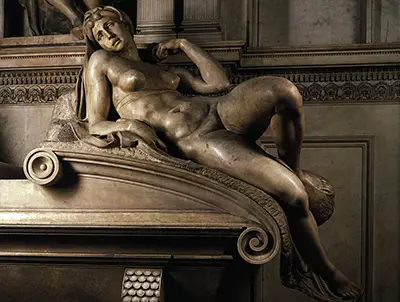And is considered as example of the style of mannerism. As part of works on the Medici family chapels, a family household that the Young Michelangelo resided in until he was 17.
Dawn is one of three statues that adorn the tomb or Lorenzo II De Medici, Duke of Urbin,a relatively 'minor' member of the family whose main claim to fame is that he was the father of Catherine de Medici, future queen of France.
The figure of dawn is the lower right figure of a composition of three figures that together create the ascetic of a perfect triangle which contributes to the allegorical meaning of the sculpture.
As one of the later works of Michelangelo, the sculpture Dawn and the burial complex of the Medici chapel and the tomb of Lorenzo, where the sculpture resides is a monument to Michelangelo's masterful skills in architecture and sculpture.
It had long been an ambition of the artist to utilize these skills within the same artistic framework and his work in the Medici Chapel realized that ambition.
The Meaning of Dawn within the Burial complex
Like all of Michelangelo works the statue dawn in more than a simple decoration. The composition and ascetic of dawn in isolation and within the context of the the tomb of Lorenzo De Medici was carefully thought out and is composed to convey multiple meanings, which scholars have discussed and disagreed on,since the statues creation.
Lorenzo was know to study the occult and his tomb holds one of the most important messages regarding the principals of alchemy:the beginning and the end of all, the circle of life. Michelangelo himself studied alchemy as a young man and these messages are represented in the tomb.
The statues, the allegories of Dusk and Dawn, and Day and Night, represent the beginning and end. The return to an androgynous state that dates back to the beginning of time.
Based on the striking similarity of female images within the chapel, it has been suggested that in the statue of Dawn, which on a fine morning gets lit by direct beams of sunlight, Michelangelo had represented the Immaculate Conception.
In fact, Dawn's face may not necessarily represent a difficult awakening, but, on the contrary, it may display a carnal languor of a satisfied desire. This notion stems from the theory that all three female statues of the Medici Chapel reflected different images of the Virgin.
The expression on the face of dawn and the reclining posture of Michelangelo's sculpture dawn reflects a complex symbolism of Human Life, where “active life” and “contemplative life” interact to free the soul after death, a philosophical concept closely linked to Michelangelo's own spirituality.
And one that breaks from Renaissance stylistic cues and exemplifies the new style of Mannerism (Derived from the Italian word 'maniera' meaning style or stylishness refers to a style of painting, sculpture and architecture, that emerged in Rome and Florence between 1510 and 1520, during the later years of the High Renaissance. Mannerism acts as a bridge between the idealized style of Renaissance art and the dramatic theatricality of the Baroque).
The perfect triangle that Dawn, Dusk and that of Lorenzo. Not only expresses the perfection of the body held within (Lorenzo the Magnificent), but also that of the missing spirit (Dusk), and the free spirit (Dawn).
Night is the allegory of gestation, the potential of the human being, which comes to life during the day. Dawn is the allegory for birth the transitional period between gestation and life. Above it, Lorenzo meditates on the secrets of the soul.
Dawn as part of the Medici Chapel is considers one of Michelangelo's greatest sculptures. It was the culmination of the refinement of the artist skill and knowledge in the representation of motion,thought and the ability to express complex philosophical ideas all within three dimensional marble.


